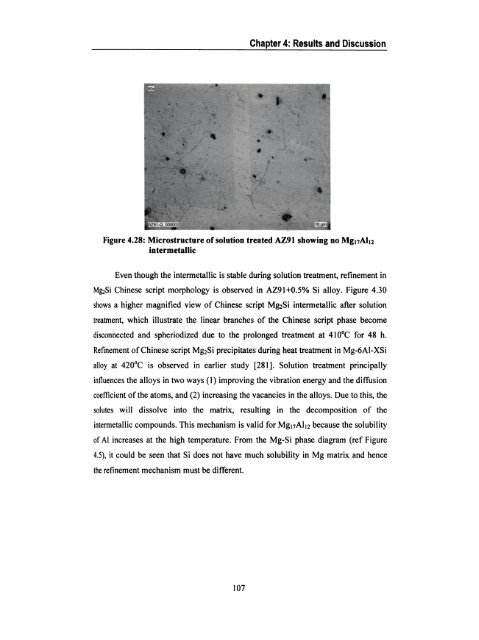“Influence of Si, Sb and Sr Additions on the Microstructure ...
“Influence of Si, Sb and Sr Additions on the Microstructure ...
“Influence of Si, Sb and Sr Additions on the Microstructure ...
Create successful ePaper yourself
Turn your PDF publications into a flip-book with our unique Google optimized e-Paper software.
Chapter 4: Results <str<strong>on</strong>g>and</str<strong>on</strong>g> Discussi<strong>on</strong><br />
Figure 4.28: <strong>Microstructure</strong> <str<strong>on</strong>g>of</str<strong>on</strong>g> soluti<strong>on</strong> treated AZ9l showing no Mg17Al1;<br />
intermetallic<br />
Even though <strong>the</strong> intermetallic is stable during soluti<strong>on</strong> treatment, refinement in<br />
Mg;<str<strong>on</strong>g>Si</str<strong>on</strong>g> Chinese script morphology is observed in AZ9l+0.5% <str<strong>on</strong>g>Si</str<strong>on</strong>g> alloy. Figure 4.30<br />
shows a higher magnified view <str<strong>on</strong>g>of</str<strong>on</strong>g> Chinese script Mg;<str<strong>on</strong>g>Si</str<strong>on</strong>g> intermetallic after soluti<strong>on</strong><br />
treatment, which illustrate <strong>the</strong> linear branches <str<strong>on</strong>g>of</str<strong>on</strong>g> <strong>the</strong> Chinese script phase become<br />
disc<strong>on</strong>nected <str<strong>on</strong>g>and</str<strong>on</strong>g> spheriodized due to <strong>the</strong> prol<strong>on</strong>ged treatment at 410°C for 48 h.<br />
Refinement <str<strong>on</strong>g>of</str<strong>on</strong>g> Chinese script Mg2<str<strong>on</strong>g>Si</str<strong>on</strong>g> precipitates during heat treatment in Mg-6Al-X<str<strong>on</strong>g>Si</str<strong>on</strong>g><br />
alloy at 420°C is observed in earlier study [28l]. Soluti<strong>on</strong> treatment principally<br />
influences <strong>the</strong> alloys in two ways (1) improving <strong>the</strong> vibrati<strong>on</strong> energy <str<strong>on</strong>g>and</str<strong>on</strong>g> <strong>the</strong> diffusi<strong>on</strong><br />
coefficient <str<strong>on</strong>g>of</str<strong>on</strong>g> <strong>the</strong> atoms, <str<strong>on</strong>g>and</str<strong>on</strong>g> (2) increasing <strong>the</strong> vacancies in <strong>the</strong> alloys. Due to this, <strong>the</strong><br />
solutes will dissolve into <strong>the</strong> matrix, resulting in <strong>the</strong> decompositi<strong>on</strong> <str<strong>on</strong>g>of</str<strong>on</strong>g> <strong>the</strong><br />
intermetallic compounds. This mechanism is valid for Mg|1Al|; because <strong>the</strong> solubility<br />
<str<strong>on</strong>g>of</str<strong>on</strong>g> Al increases at <strong>the</strong> high temperature. From <strong>the</strong> Mg-<str<strong>on</strong>g>Si</str<strong>on</strong>g> phase diagram (ref Figure<br />
4.5), it could be seen that <str<strong>on</strong>g>Si</str<strong>on</strong>g> does not have much solubility in Mg matrix <str<strong>on</strong>g>and</str<strong>on</strong>g> hence<br />
<strong>the</strong> refinement mechanism must be different.<br />
107<br />
l<br />
l
















